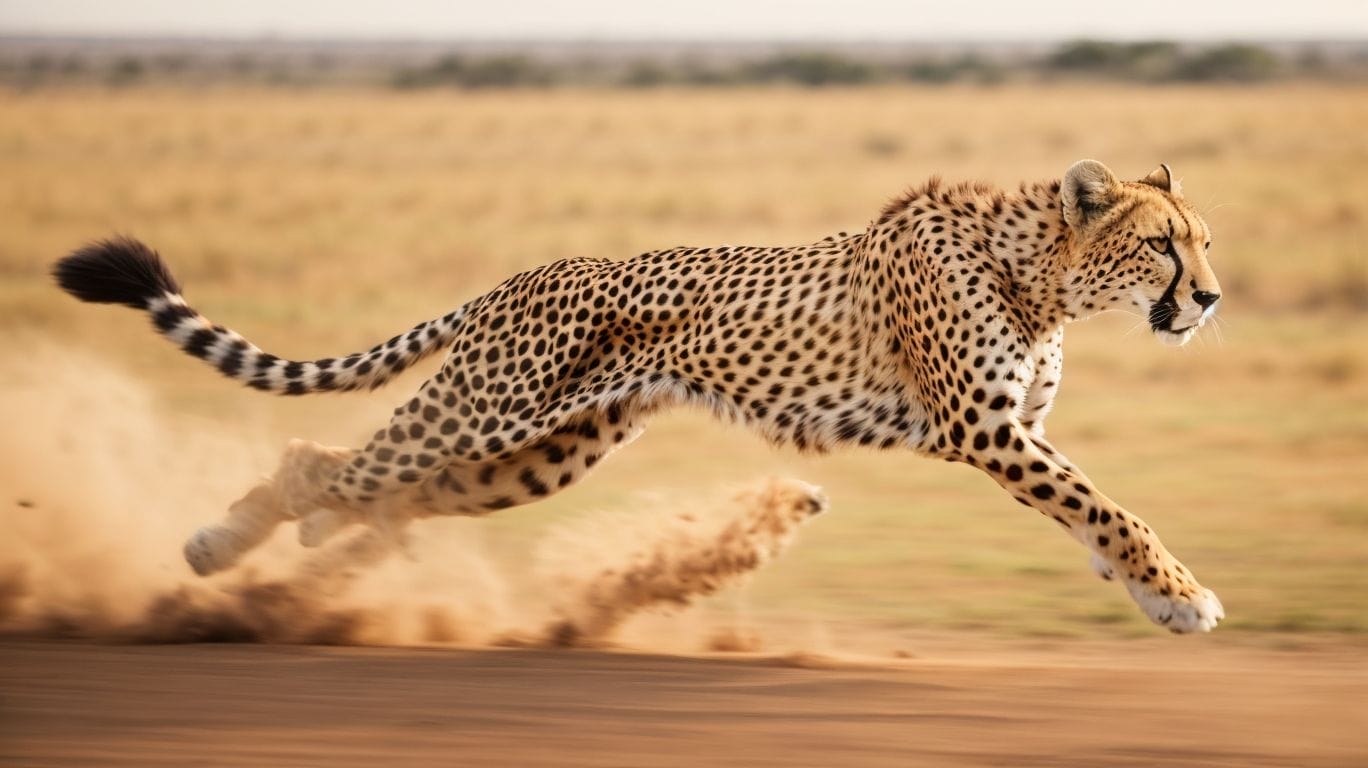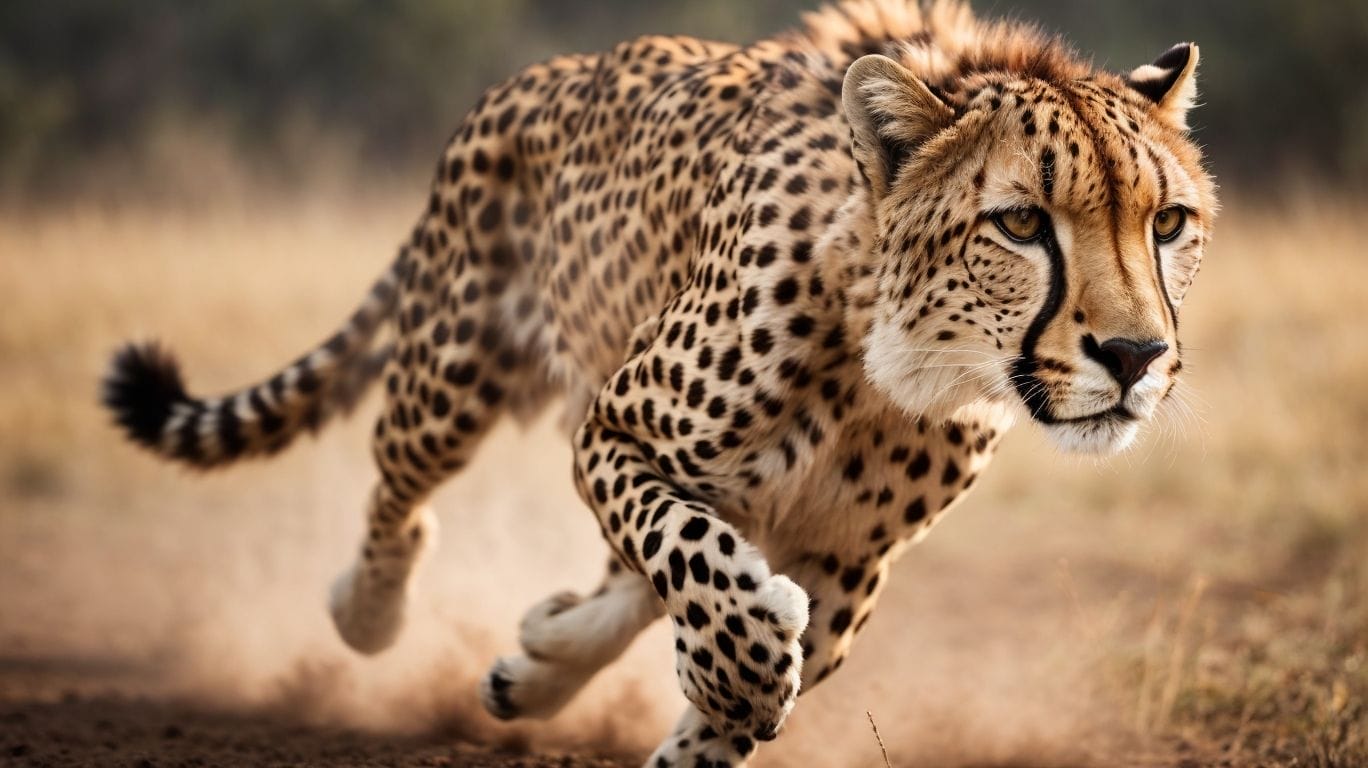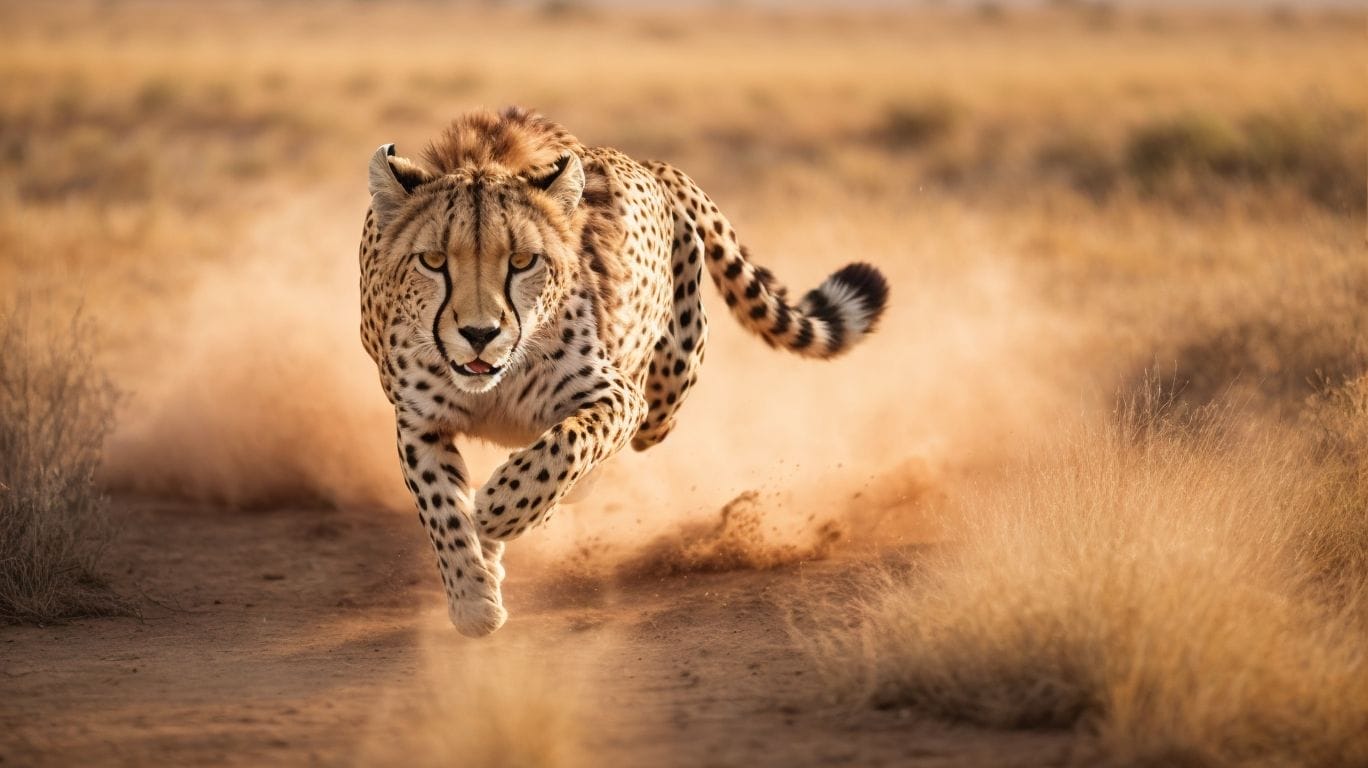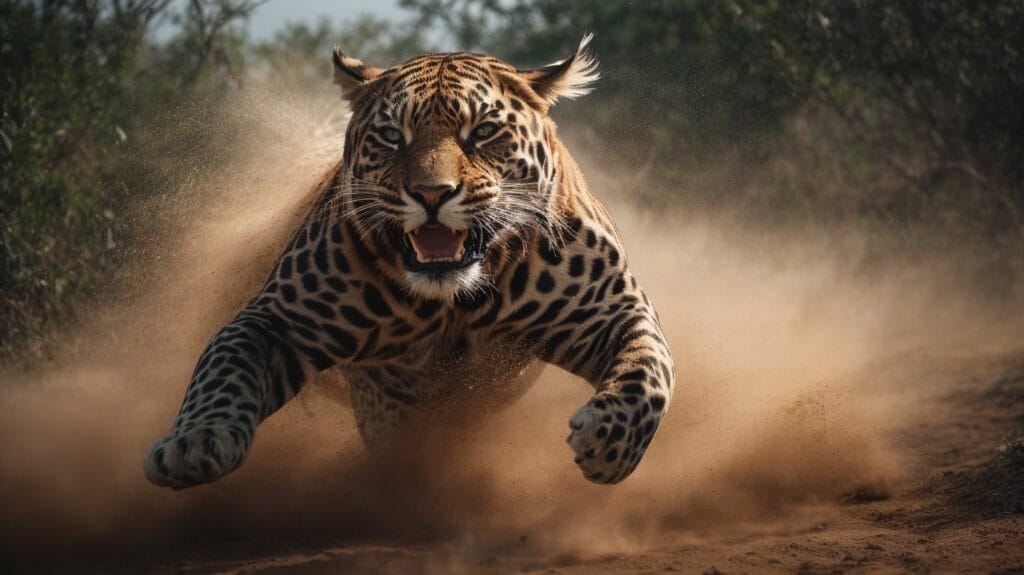The speed at which animals can move is remarkable and varies greatly across different species. Several factors contribute to an animal’s speed, including body size and shape, limb structure, muscle composition, and energy metabolism. Understanding these factors can help us determine which animal holds the title of being the fastest.
When it comes to speed, the cheetah often takes the spotlight. Known for its incredible sprinting abilities, the cheetah can reach up to 70 miles per hour in short bursts. However, there are other contenders in the animal kingdom for the title of the fastest. The peregrine falcon, known for its high-speed dives during hunting; the sailfish, renowned for its agility and swimming speed; the pronghorn antelope, known for its impressive long-distance running capability; the Brazilian free-tailed bat, recognized for its swift flight; and the spur-winged goose, which can fly at remarkable speeds.
These animals achieve such high speeds through various adaptations that allow them to excel in their respective habitats. Whether it’s specialized running adaptations, such as long limbs or streamlined bodies, adaptations for Flying, such as wings designed for efficient lift and maneuverability, or adaptations for swimming, like streamlined bodies and powerful fins, these animals have evolved to maximize their speed and mobility.
While humans cannot match the speed of the fastest animals, we have our achievements in speed. Regarding sprinting, the fastest human can reach around 27 miles per hour. In the water, the fastest human swimmer can reach approximately 6 to 8 miles per hour. On land, the fastest human, Usain Bolt, has reached 27.8 miles per hour. While impressive, these speeds still fall short compared to the fastest animals.
Key takeaways:
Key takeaway:
- Cheetah: The cheetah is the fastest land animal, reaching up to 70 miles per hour. Its body size, limb structure, and muscle composition contribute to its incredible speed.
- Peregrine Falcon: The peregrine falcon is the fastest bird, capable of reaching speeds over 200 miles per hour during its hunting dives. Its streamlined body and powerful wings are crucial in achieving such high speeds.
- Sailfish: The sailfish is the fastest swimmer, clocking in at speeds up to 68 miles per hour. Its long, slender body, rigid dorsal fin, and powerful tail allow it to move quickly through the water.
Factors Affecting Speed in Animals
Discover the secrets of speed in the animal kingdom by exploring factors influencing their swift movements. From body size and shape to limb structure, muscle composition, and energy metabolism, we’ll unveil how these attributes contribute to an animal’s extraordinary velocity. Get ready to dive into the fascinating world of animal adaptations and uncover the intriguing science behind their lightning-fast abilities. Speed enthusiasts, buckle up for an exhilarating journey through the wild!
Body Size and Shape
Their body size and shape significantly influence the speed of animals. Animals with larger bodies can take longer strides and generate more power, resulting in faster movements. Streamlined and aerodynamic body shapes help animals reduce air resistance, allowing them to achieve higher speeds. An excellent example is cheetahs, which have slender bodies and long legs, enabling them to reach incredible speeds of up to 70 mph (112 km/h). In contrast, pronghorn antelopes have compact and muscular frames well-suited for endurance, enabling them to maintain speeds of around 55 mph (88 km/h) for longer periods. These adaptations in body size and shape contribute to the remarkable speed capabilities of different animals.
Similarly, the design of modern trains is inspired by animal forms, particularly their streamlined structure. The bullet train in Japan, for instance, draws inspiration from the beak shape of the kingfisher bird to reduce noise and energy consumption. This real-life example demonstrates the importance of studying animal adaptations in developing efficient transportation systems.
Limb Structure
Regarding speed in animals, limb structure plays a crucial role. Limb structure encompasses several factors contributing to an animal’s ability to move quickly. These factors include limb length, muscle attachment points, bone structure, joint flexibility, and foot shape.
Muscle Composition
Muscle composition plays a crucial role in determining an animal’s speed. The table below showcases the muscle composition of various animals known for their speed:
| Animal | Muscle Composition |
| Cheetah | A large proportion of fast-twitch muscle fibers provide explosive power |
| Peregrine Falcon | Strong chest muscles for rapid flapping of wings |
| Sailfish | Long, streamlined body with powerful, flexible muscles |
| Pronghorn Antelope | Efficient oxygen delivery to muscles for sustained speed |
| Brazilian Free-Tailed Bat | Muscles specialized for quick acceleration and maneuverability in flight |
| Spur-Winged Goose | Strong wing muscles for powerful flapping during flight |
By studying the unique muscle compositions of these animals, scientists can gain insights into the factors that contribute to their extraordinary speed.
Energy Metabolism
Energy metabolism plays a vital role in determining the speed and endurance of animals. It refers to the processes by which organisms convert food into energy. Animals with higher energy metabolism rates tend to have more energy for movement, making them faster. For example, the cheetah‘s efficient energy metabolism enables it to sprint at incredible speeds. Similarly, the peregrine falcon‘s high energy metabolism rate allows it to reach astonishing speeds during its hunting dives. Understanding energy metabolism helps us appreciate how animals achieve their remarkable velocities and highlights the biological factors contributing to their incredible speed.
Which Animal Holds the Title of the Fastest?

Photo Credits: Petnarnia.Com by Bradley Carter
Regarding speed, the animal kingdom never fails to amaze us. In this section, we’ll dive into the thrilling world of speedsters and explore which animal holds the coveted title of being the fastest. Get ready to meet the awe-inspiring cheetah, the lightning-fast peregrine falcon, the sleek sailfish, the swift pronghorn antelope, the agile Brazilian free-tailed bat, and the surprising spur-winged goose. Hold on tight because we’ll witness some incredible velocity moments in the animal kingdom.
Cheetah
The cheetah, the fastest land animal, can reach up to 70 mph in short bursts. This incredible speed is made possible by the cheetah’s unique physique. With a slender body, long legs, and a flexible spine, the cheetah maximizes stride length for swift movement. Its lightweight build and strong muscles provide the power needed to accelerate quickly. Additionally, the cheetah possesses large nasal passages and lungs, allowing it to intake more oxygen during high-speed pursuits. To further enhance its running abilities, the cheetah has non-retractable claws and specialized feet that grant excellent traction. These adaptations enable the cheetah to chase down prey and thrive in its natural habitat.
| Fact | Details |
| Speed | The cheetah can reach speeds up to 70 mph. |
| Physique | Slender body, long legs, and a flexible spine. |
| Muscles | Strong muscles for acceleration and power. |
| Respiration | Large nasal passages and lungs for increased oxygen intake. |
| Feet | Specialized feet for excellent traction while running. |
Peregrine Falcon
The Peregrine Falcon is widely regarded as the fastest animal on Earth. In level flight, it can reach up to 240 miles per hour (386 kilometers per hour). These magnificent birds achieve such high speeds due to their unique adaptations for flying. Their streamlined body shape, powerful flight muscles, and specialized feathers contribute to their impressive speed. The Peregrine Falcon hunts by diving from great heights, known as a stoop, to strike its prey mid-air. This incredible speed and agility make the Peregrine Falcon a formidable hunter in the skies.
Sailfish
The sailfish is known for its incredible speed and agility in the water. Here are some key facts about sailfish:
| Size | The sailfish is one of the fastest fish in the ocean, reaching lengths of up to 10 feet. |
| Speed | It can swim up to 68 miles per hour, making it one of the fastest animals in the water. |
| Adaptations | The sailfish has a streamlined body, a long bill, and a large dorsal fin, which helps it to swim quickly and maneuver easily in the water. |
| Feeding Habits | Sailfish are known for their hunting technique called “bill slashing,” where they use their bills to stun or injure their prey before consuming it. |
To witness the impressive speed and agility of the sailfish, you can visit destinations like Costa Rica, Mexico, or Florida, where you can go deep-sea fishing or snorkeling to observe these magnificent creatures in their natural habitat. Have an exciting and unforgettable experience encountering sailfish in action!
Pronghorn Antelope
The Pronghorn Antelope is renowned for its remarkable speed and agility. This species is the second-fastest land animal, reaching speeds of up to 55 miles per hour (88 kilometers per hour). The Pronghorn Antelope possesses several adaptations that contribute to its impressive speed. Its long, powerful legs, lightweight body, and efficient metabolism enable it to sustain high speeds for extended periods. Its exceptional vision allows it to detect predators from afar, aiding in its evasion tactics. Studying these adaptations can provide insights into the remarkable capabilities of the Pronghorn Antelope and inspire advancements in human athleticism.
Brazilian Free-Tailed Bat
The Brazilian Free-Tailed Bat, scientifically known as Tadarida brasiliensis, is hailed as one of the fastest-flying animals worldwide. Recognized for their exceptional speed and agility, these bats can reach impressive speeds of up to 99 miles per hour (160 kilometers per hour) during level flight. This remarkable achievement is made possible by a combination of adaptations, including the bat’s streamlined body shape, powerful wings, and remarkable maneuverability. Thus, the Brazilian Free-Tailed Bat is a remarkable example of how animals have evolved to excel in specific environments, enabling them to achieve incredible speeds.
Spur-Winged Goose
The Spur-Winged Goose is a large bird found in Africa, known for its impressive speed and agility. With a wingspan of up to six feet, it can reach up to 88 miles per hour in flight. This makes it one of the fastest-flying birds in the world. The Spur-Winged Goose achieves these high speeds through its aerodynamic body shape and powerful wing muscles. It also has adaptations such as long legs and webbed feet, which allow it to navigate through water with ease. The Spur-Winged Goose is a remarkable example of nature’s ability to create fast and agile creatures.
As a true historical example of speed, the Wright brothers’ first sustained flight in 1903 reached only 30 miles per hour, highlighting the impressive capabilities of animals like the Spur-Winged Goose.
How Do These Animals Achieve Such High Speeds?

Photo Credits: Petnarnia.Com by Jeremy Scott
Have you ever wondered how some animals achieve incredible speeds? In this section, we’ll unravel the secrets behind their impressive abilities. From adaptations for running to adaptations for Flying and swimming, we’ll explore the remarkable techniques and physical traits that enable these animals to move with such extraordinary speed. Buckle up because we’re about to dive into the world of nature’s fastest creatures.
Adaptations for Running
Adaptations for running in animals encompass various physical characteristics and abilities that boost their speed and agility. These adaptations include:
| 1. Streamlined body shape: | Animals, like cheetahs with elongated bodies and tapered ends, can minimize air resistance and maximize their efficiency while running. |
| 2. Long limbs: | Certain animals, such as pronghorn antelopes, have longer legs, allowing them to take larger strides and achieve faster movements. |
| 3. Specialized muscles: | Animals like cheetahs possess specialized muscles, such as powerful hind legs and a flexible spine, which enable them to experience explosive acceleration and make quick changes in direction. |
| 4. Enhanced respiratory system: | Just like marathon-running humans, animals with adaptations for running have highly efficient oxygen delivery systems. Their well-developed lungs and increased red blood cells ensure sustained speed. |
These running adaptations grant animals the remarkable ability to reach incredible speeds, surpassing the pure speed and endurance capabilities of humans.
Adaptations for Flying
- Adaptations for Flying include a lightweight body structure to reduce drag and enable quick takeoff.
- Adaptations for Flying also involve wings with large surface areas and streamlined shapes to generate lift and minimize air resistance.
- Strong flight muscles that allow for powerful and efficient wing movements are another key adaptation for flying.
- Elongated and flexible wings enhance maneuverability and control during flight, contributing to the adaptations for Flying.
- Keen eyesight and spatial awareness play a crucial role in the adaptations for Flying, as they help animals navigate through the air and spot prey or obstacles.
These various adaptations for flying enable animals like birds, bats, and insects to achieve impressive speeds and execute agile aerial maneuvers. By studying and understanding these adaptations, scientists and engineers have been able to develop innovations in aviation and improve aircraft design.
Next time you marvel at the grace and speed of a bird or a bat in flight, remember the incredible adaptations for flying that make it all possible. Shall we take inspiration from nature’s flyers and reach new heights ourselves?
Adaptations for Swimming
Swimming is a skill that requires specific adaptations for swimming in animals to achieve high speeds in water. Some key adaptations for swimming include:
Would you like to learn more about which animal is the fastest? Visit Which Animal is the Fastest?
- Streamlined body shape: Animals have streamlined bodies with tapered ends to reduce drag in the water.
- Powerful tails: A strong and flexible tail is crucial for generating propulsion and steering.
- Muscular flippers or fins: Animals like dolphins and whales have muscular flippers or fins that provide control and speed in the water.
- Efficient respiratory system: Aquatic animals have evolved specialized respiratory systems to extract oxygen from water efficiently.
- Webbed feet or flippers: Ducks, penguins, and other water-dwelling animals have webbed feet or flippers to increase surface area for better propulsion.
To swim efficiently, humans can learn from these adaptations by practicing proper body alignment, using powerful leg and arm movements, and improving breath control.
Can Humans Compete with the Fastest Animals?

Photo Credits: Petnarnia.Com by Paul Martinez
Can humans compete with the fastest animals? Let’s dive into the world of speed and explore the realms of the fastest human sprint, conquering the waves as the fastest human in water and blazing across land as the fastest human. Get ready to be amazed by the incredible feats of human speed as we compare them to the feral swiftness of the animal kingdom.
Fastest Human Sprint
The fastest human sprint is an impressive display of athleticism and speed. When discussing the fastest human sprint, there are several factors to consider:
- Training: Athletes undergo extensive training to enhance and improve their speed and explosiveness.
- Technique: Utilizing proper running technique, including stride length and frequency, is essential in maximizing speed.
- Muscle Development: Developing powerful leg muscles, such as the quadriceps and hamstrings, is crucial for generating speed.
- Biomechanics: Understanding the biomechanics of sprinting allows athletes to optimize their movements, resulting in maximum efficiency.
- Nutrition and Recovery: Proper nutrition and recovery are vital in improving performance and preventing injuries.
In addition to these factors, true stories like Usain Bolt’s world-record-breaking sprints provide us with a glimpse into the extraordinary capabilities of the human body in terms of speed. Usain Bolt, widely acclaimed as the fastest man in history, set the world record for the 100-meter sprint in 2009, achieving an astonishing time of 9.58 seconds. His unparalleled speed and athleticism continue to inspire athletes worldwide.
Fastest Human in Water
- Michael Phelps: Known as the most decorated Olympian, Phelps holds multiple world records in swimming events.
- Adam Peaty: British swimmer known for his dominance in breaststroke events, holds the world record in the men’s 100m breaststroke.
- Simone Manuel: American swimmer who made history as the first African-American woman to win an individual Olympic gold medal in swimming.
- Katie Ledecky: American distance swimmer who holds multiple world records in freestyle events and has won numerous Olympic gold medals.
- Florence Griffith-Joyner: American sprinter and Olympic champion known for her amazing speed in the water.
When it comes to swimming, humans have achieved impressive speeds. While they cannot compete with the fastest animals in water, human swimmers like Michael Phelps and Adam Peaty have shown remarkable speed and agility. Their training, technique, and physical attributes contribute to their success in the water. To improve your speed in the water, focus on proper technique, strength training, and endurance exercises. Don’t forget to warm up, stretch, and stay hydrated before any swim session.
Fastest Human on Land
The title of the fastest human on land belongs to Usain Bolt, a Jamaican sprinter known for his incredible speed. Bolt, a record holder in the 100-meter and 200-meter races, has achieved a top speed of 27.8 miles per hour (44.7 kilometers per hour). Numerous factors contribute to Bolt’s remarkable speed, including his body size, muscle composition, and energy metabolism. With his long legs and fast twitch muscle fibers, Bolt can generate explosive power and cover ground rapidly. It is no wonder that Bolt’s exceptional speed has earned him multiple Olympic gold medals and the renowned title of the fastest human on land.
Some Facts About Which Animal is the Fastest:
- ✅ The cheetah is the fastest land animal, reaching speeds of 113kph (70mph), three times faster than a human’s top running speed. (Source: Our Team)
- ✅ The peregrine falcon is the fastest bird and the fastest animal in the world, reaching speeds of over 300 km/h (190 mph) when diving. (Source: Our Team)
- ✅ The pronghorn antelope is the second fastest land animal and can reach speeds of 98kph (60mph). (Source: Our Team)
- ✅ The sailfish is the fastest fish, reaching 110kph (68mph). (Source: Our Team)
- ✅ The frigate bird can reach speeds of 153kph (95mph) and has the largest wingspan to body weight ratio of any bird. (Source: Our Team)


